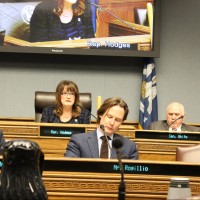
$200 Million Needed to Complete Canal
Frustrated by the snail’s pace of construction on the Comite Diversion Canal, Rep. Valarie Hodges (R-Central) organized the Comite Diversion Canal Task Force to find out why it has taken so long and what can be done to complete it. The task force met at the State Capitol and heard from citizens who feel the project could have prevented them from being flooded during the 1,000-year flood in August.
The highlight of the meeting was a presentation by Legislative Auditor Daryl Purpera who was charged by the legislature with preparing a report on the diversion canal project.
Purpera said the primary reason the project has taken so long is delays caused by inadequate and inconsistent delivery of federal funds for the project through the Corps of Engineers. Purpera said the project, first approved by the legislature in 1992, is viable only if a reliable revenue stream is available from federal funds.Baton Rouge area legislators led by Rep. Valarie Hodges (R-Central) have formed the Task Force on the Comite Diversion Canal in an attempt to speed up the building of the project. The canal would divert water from the Comite River to the Mississippi River when the Comite is approaching flood stage. The Task Force met Wednesday, Jan. 25 in House Committee Room 6 at the State Capitol. A number of witnesses spoke including Legislative Auditor Daryl Purpera, who had been commissioned to investigate why the project has been delayed and what can be done to put it on track. Here are highlights of the Legislative Auditor’s report:
“Although approximately $117 million has been spent from federal, state, and local funding sources, only one of the 27 construction components of the project has been completed. In addition, although the project was originally estimated to be completed in 2012 at a cost of $153 million, current estimates by the Corps indicate that the project will take two to three years to complete, and the cost may be as high as $313 million, which is $160 million over initial Congressional authorization. However, completion of the project is dependent upon funding, which has been insufficient and inconsistent since the project commenced. We identified the following issues as reasons for delays with the Comite Project:
• “A lack of consistent and sufficient funding for the Corps is the primary reason that the project has not moved forward, resulting in little construction progress since 2000. Only the Lilly Bayou control structure has been completed. • “Insufficient purchasing of mitigation land by the Corps when it was acting on DOTD’s behalf for Lands, Easements, Right of Ways, Relocations, and Diversions (LERRDs) caused delays in the project, which is the reason DOTD took back LERRDs. In addition, state legislation in 2010 prohibited the expropriation of land for the Comite Project, which resulted in the Corps having
to identify new mitigation land.
• “The current construction delay is the U.S. Highway 61 bridge construction and the associated utility relocations that must take place. DOTD must relocate utilities, such as pipelines and telecommunications lines, at this location prior to bridge construction; however, DOTD stated that it is concerned that no federal funding will be approved for the project and money spent to relocate utilities will therefore be wasted.
“Federal funding has ranged from $0 in 2011 to $12.3 million in 2007. While federal funding has been available in most fiscal years, the money has not come in sufficient amounts to complete large components of the project.
“State funding has also been inconsistent and unpredictable throughout the life of the project. The highest appropriation received through the state’s capital outlay process by DOTD was $5 million in 2008 and by ARBC was $287,400 in 2011.
“DOTD has not received capital outlay funding from the state for the Comite Project since 2010, and ARBC has not received an appropriation from the state since 2012.
“The tax paid by the locals in the benefit area to ARBC has been the most consistent source of funding for the project, as it has been provided every year since 2002 and has increased from $1.1 million in 2002 to $2.6 in 2016.
“Another issue with federal funding is that the money appropriated for the Comite Project can be used for other federal projects if it is not spent within the federal fiscal year in which it was appropriated.
“In August 2016, Governor John Bel Edwards requested a federal aid package to help with flood recovery after the flooding of August 2016. On September 28, 2016, Congress passed a bill that included $438 million in federal aid for flood damage, and $1.24 billion in additional flood relief aid was passed on December 6, 2016. Funds were not designated specifically for the Comite Project in either federal aid package.
“All parties agree that a more comprehensive approach is needed for the entire Comite and Amite River Basin area; however, all cite federal funding as a hindrance to that being accomplished.
“Due to the significant delays and unpredictable funding, the legislature, the Comite River Diversion Canal Project Task Force, and stakeholders may wish to determine if the Comite Project is still a viable project for the state or if it should be revised to fit into a larger flood protection strategy for the region.”
The entire report can be found online at www.lla.la.gov.
In response to the Legislative Auditor’s report, the Amite River Basin Committee filed comments which included the following:
“ARBC is in agreement with the Legislative Auditor’s conclusions concerning the delay in completion of the Project. The Project is viable and much needed. It would be irresponsible to abandon this Project after spending $39 million in non-federal funds and $78 million by the federal government. Gov. John Bel Edwards has requested direct federal funding in his disaster request to complete this Project. We urge the Trump administration and Congress to secure the necessary funds.”


 February 9, 2017
February 9, 2017 







Comments are closed.